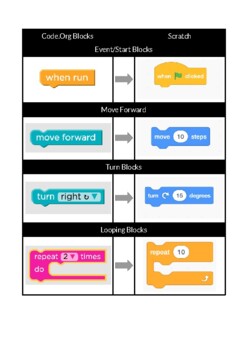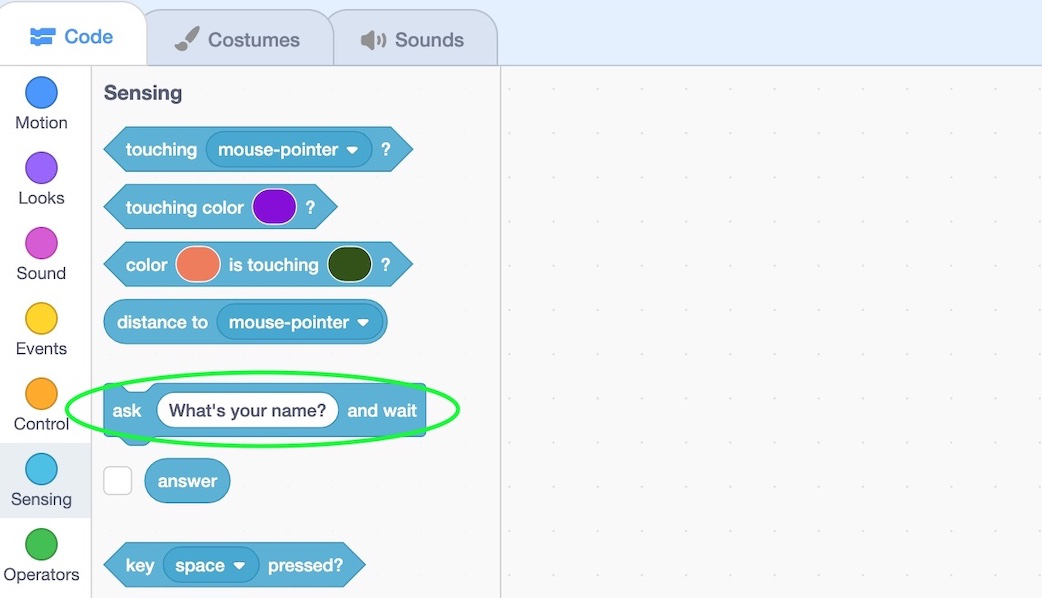

Scratch 2.0 had the following three Looks Reporter blocks: go back () layers - Changed the sprite's layer value by the amount.go to front - Put a sprite in the front.set size to ()% - Set the sprite's size to the amount.change size by () - Changed the sprite's size by the amount.clear graphic effects - Cleared all graphic effects on the sprite.set effect to () - Set the specified effect to the amount.change effect by () - Changed the specified effect by the amount.next costume/ next backdrop - Changed the sprite's/Stage's costume/backdrop to the next one in the costume list.switch backdrop to and wait - Like the Switch to Backdrop () block, though it waited until all of the hat blocks triggered by this had completed.switch costume to / switch backdrop to - Changes the sprite's/ Stage's costume/ backdrop to the specified one.think () - A thought bubble appeared over the sprite and would not go away over time.think () for () secs - A thought bubble appeared over the sprite and stayed for the specified amount of time.say () - A speech bubble appeared over the sprite and would not go away over time.say () for () secs - A speech bubble appeared over the sprite and stayed for the specified amount of time.Scratch 2.0 had the following sixteen looks stack blocks: Three of the 19 sprite looks blocks have a counterpart for the Stage. There were 23 looks blocks in Scratch 2.0. Looks blocks were the blocks that control a sprite's look. direction - The direction of the sprite.y position - The Y position of the sprite.x position - The X position of the sprite.Scratch 2.0 had the following three motion reporter blocks: set rotation style This set the rotation style of a sprite.if on edge, bounce - If a sprite was touching the edge of the screen, its direction flipped over.set y to () - Set the sprite's Y position to the amount.change y by () - Changed the sprite's Y position by the amount.set x to () - Set the sprite's X position to the amount.change x by () - Changed the sprite's X position by the amount.glide () secs to x: () y: () - Glided the sprite to the location, taking as long as the specified amount of time.go to - Moved the sprite to the mouse-pointer or another sprite.


Motion blocks Main article: Motion Blocks There were two Cap blocks which can both be found in the Control category. They were shaped with a notch at the top and a flat bottom - this was so no blocks could be placed below them. Main article: Cap BlockĬap blocks were the blocks that ended scripts. In total, there were eleven Hat Blocks, five C Blocks, thirty-seven Reporter Blocks, thirteen Boolean Blocks, two Cap Blocks and seventy-seven Stack Blocks. Only ten of these were shown in the Block Palette. In Scratch 2.0, there were twelve categories of blocks: motion, looks, sound, pen, variables, list, events, control, sensing, operators, more blocks, PicoBoard, and LEGO Education WeDo 2.0 (although there were some other categories and blocks in some Scratch modifications).
#Scratch code blocks series#
Series of connected blocks are called scripts. The blocks connect to each other like a jigsaw puzzle, where each data type (event, command, reported value, reported boolean, or script end) has its own shape and a specially shaped slot for it to be inserted into which prevent syntax errors. For this article in Scratch 1.4, see Blocks (1.4).īlocks are puzzle-piece shapes that are used to create code in Scratch. For this article in the current version ( version 3.0), see Blocks (3.0). This article or section documents an outdated version of Scratch ( version 2.0). It is only useful from a historical perspective. This article or section documents something not included in the current version of Scratch ( 3.0). Remember to stay safe while using the internet, as we cannot guarantee the safety of other websites.

This article has links to websites or programs not trusted by Scratch or hosted by Wikipedia.


 0 kommentar(er)
0 kommentar(er)
